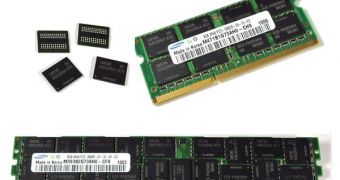Economic issues still plaguing different parts of the world aside, Samsung's aggressive investments in advanced manufacturing technologies turned out in its favor, allowing it to strengthen its dominance on the DRAM market and visibly outdo its competitors during Q2, 2010.
The overall industry soared and reached revenues of US$10.8 billion during the second quarter of 2010, 14.4% more than the US$9.4 billion that the first one yielded, according to iSupply.
Apparently, Q2 is the best one experienced by this industry since the end of 1995, as shipments amounted to 3.56 billion 1Gb-equivalent units.
What's more, the ASP (average selling price) of US$3.03 is supposedly the highest one since the third quarter of 2008.
In this context, Samsung produced 1.2 billion 1Gb-density-equivalent DRAM units, quite a large slice of the total, which is 13% more than the 1.1 billion from Q1. Also, the average ASP was of US$3.13.
In terms of revenues, the outfit's US$3.8 billion showed a 24.3% jump over the US$3.1 billion from the previous three-month period, which is also the highest growth rate among the top five DRAM makers.
All in all, the IT company accounted for 35.4% of global DRAM revenues, more than the 32.6% of the second quarter.
"Samsung's memory business long has pursued a strategy of taking the leadership in investment in new manufacturing processes, allowing it be the first to move to advanced semiconductor process geometries, and thus enabling the company to make semiconductors at a lower cost and at greater efficiency than its competitors," said Mike Howard, senior analyst for DRAM technology at iSuppli.
"The company's aggressive push into 40nm semiconductor lithography for DRAM manufacturing boosted the volume of its bit production dramatically. Meanwhile, Samsung's broad DRAM portfolio, including high-end devices like mobile and legacy parts, allowed it to achieve an ASP higher than the industry average," he added.

 14 DAY TRIAL //
14 DAY TRIAL //